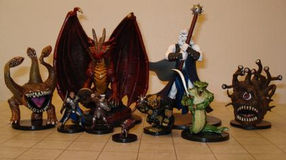Gamestorming #1: Lost Civilization
- Caity Kelly
- Feb 1, 2019
- 3 min read
When considering a learning context in which a more engaging, enjoyable tool is desperately needed, one of the first things that comes to my mind is GRE test prep. Simply uttering the name often elicits a shudder of unpleasant nostalgia from many graduate students...perhaps we could use games to help change this?
The premise of the game is that the story is set in a post-apocalyptic future (hundreds of years in the future) in which much of the world is being rebuilt after a robot/AI disaster. The player finds himself/herself the new intern at a research facility, whose goal is to recover information lost from earlier time periods (around our time period now) from remnants of technology that have been uncovered in the restoration process. I chose this setting deliberately--why would the characters have trouble deciphering our technology and records if something had not occurred to make this difficult? I found that these questions are important to consider when creating a game with a narrative. If the story has major plot holes, it distracts the players from the game itself.
You may be wondering, where does the GRE come in? The levels in this game are designed to practice skills that are used on the test in a way that works toward a goal of helping the characters restore their records of our civilization. Upon completing each level in a timely, accurate fashion, the player choose what type of reward he/she would like. These include coins to further customize his/her avatar with fun outfits, access to fun "study break" minigames that the player can use for a "brain break," and "hint points" that the player can spend if he/she gets stuck on a problem. The more quickly the player can arrive at the right answer to the problem, the more choices he/she will have for a reward.
Since the GRE is quite a broad area of study, I have not formulated a level for every type of practice needed; however, I have "gamestormed" ideas for a few of the most prominent areas: Reading comprehension and mathematics.
For the reading comprehension level, the player must go through old, damaged books and academic papers. Many of the words are difficult to see and, without full context, the researchers are having difficulty deciphering the author's intentions. The player's job is to analyze the text and answer questions about authors intent, word choice, argument support/weakening statements, and other verbal-based problems. During early levels, the challenge is easier as the scientist who scaffolds the player through the beginning levels of the game will point out important words in the text that can help them arrive at an answer. As the levels get more difficult, these tips disappear.
Regarding the mathematics section, this takes place in the technology-focused wing of the research facility. Now, math is not my strong suit but I did come up with an order of operations problem that is quite different than the problem I imagined for Lure of the Labyrinth. In this area of the facility, scientists are trying to rebuild remnants of old technology. They have recently found pieces of an old computer but the pieces have been scattered all over a VERY messy room filled with parts, tools, and robotics. The player must first play a "search and find" game to find each component of the computer among the clutter in the room. Adults tend to enjoy games like this; they are quite popular, even among non-gamers.
Once the player finds all components, he/she will notice that each one is marked with a symbol from the order of operations. He/she must arrange them in the order of operations (PEMDAS) in order to rebuild the computer. Once this is complete, a scientist character will plug the computer in and turn it on...only to discover that it is locked for privacy. In order to get into it, the player must "crack the code" by solving order of operations problems. Only then can the scientists investigate the computer's contents.
The art style of the game is animated; however, it is a more adult, realistic style of animation. Many of the characters will be "futuristic" scientists, looking something like this (taken from a royalty-free image collection):

Image source: https://commons.wikimedia.org/wiki/File:Genghis-jones-pod-active_mango_concept-art_02.png
As I mentioned before, there are a myriad of other levels to practice GRE skills. The overall goal of the game is to be able to supplement tedious test study with something that is more fun and engaging. Once the player finishes the game, he/she will earn a QR code discount to several brands of GRE test study books.


Comentarios